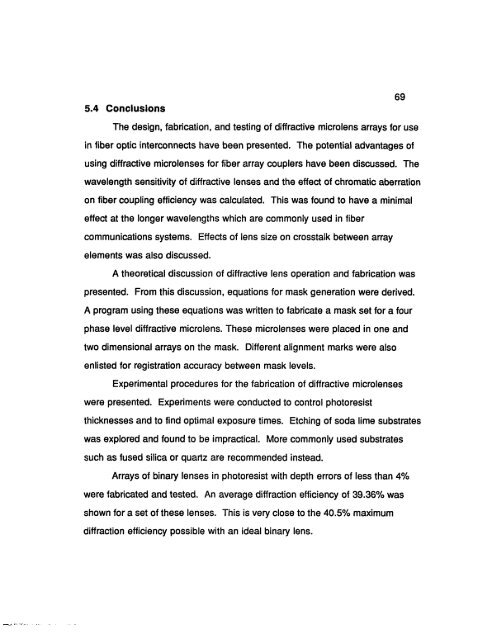azu_td_1349475_sip1_... - Arizona Campus Repository
azu_td_1349475_sip1_... - Arizona Campus Repository
azu_td_1349475_sip1_... - Arizona Campus Repository
Create successful ePaper yourself
Turn your PDF publications into a flip-book with our unique Google optimized e-Paper software.
5.4 Conclusions<br />
69<br />
The design, fabrication, and testing of diffractive microlens arrays for use<br />
in fiber optic interconnects have been presented. The potential advantages of<br />
using diffractive microlenses for fiber array couplers have been discussed. The<br />
wavelength sensitivity of diffractive lenses and the effect of chromatic aberration<br />
on fiber coupling efficiency was calculated. This was found to have a minimal<br />
effect at the longer wavelengths which are commonly used in fiber<br />
communications systems. Effects of lens size on crosstalk between array<br />
elements was also discussed.<br />
A theoretical discussion of diffractive lens operation and fabrication was<br />
presented. From this discussion, equations for mask generation were derived.<br />
A program using these equations was written to fabricate a mask set for a four<br />
phase level diffractive microlens. These microlenses were placed in one and<br />
two dimensional arrays on the mask. Different alignment marks were also<br />
enlisted for registration accuracy between mask levels.<br />
Experimental procedures for the fabrication of diffractive microlenses<br />
were presented. Experiments were conducted to control photoresist<br />
thicknesses and to find optimal exposure times. Etching of soda lime substrates<br />
was explored and found to be impractical. More commonly used substrates<br />
such as fused silica or quartz are recommended instead.<br />
Arrays of binary lenses in photoresist with depth errors of less than 4%<br />
were fabricated and tested. An average diffraction efficiency of 39.36% was<br />
shown for a set of these lenses. This is very close to the 40.5% maximum<br />
diffraction efficiency possible with an ideal binary lens.
















